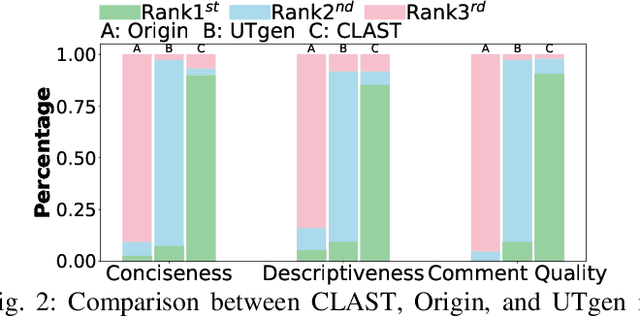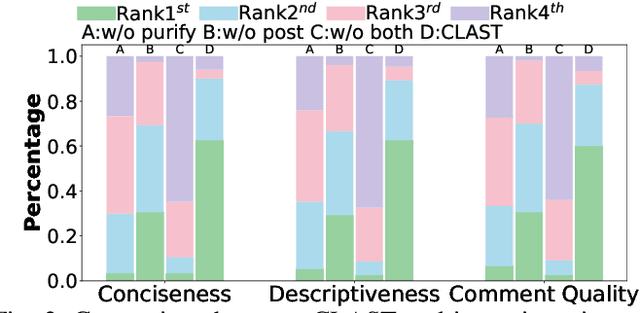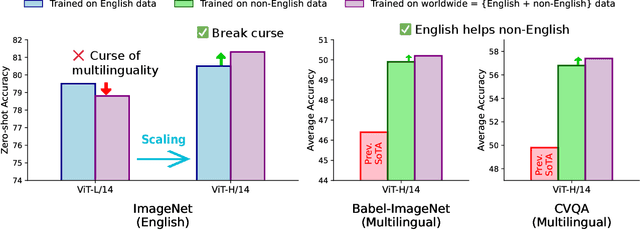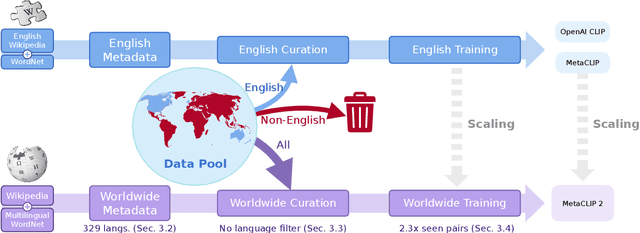Dong Wang
Trajectory Conditioned Cross-embodiment Skill Transfer
Oct 09, 2025Abstract:Learning manipulation skills from human demonstration videos presents a promising yet challenging problem, primarily due to the significant embodiment gap between human body and robot manipulators. Existing methods rely on paired datasets or hand-crafted rewards, which limit scalability and generalization. We propose TrajSkill, a framework for Trajectory Conditioned Cross-embodiment Skill Transfer, enabling robots to acquire manipulation skills directly from human demonstration videos. Our key insight is to represent human motions as sparse optical flow trajectories, which serve as embodiment-agnostic motion cues by removing morphological variations while preserving essential dynamics. Conditioned on these trajectories together with visual and textual inputs, TrajSkill jointly synthesizes temporally consistent robot manipulation videos and translates them into executable actions, thereby achieving cross-embodiment skill transfer. Extensive experiments are conducted, and the results on simulation data (MetaWorld) show that TrajSkill reduces FVD by 39.6\% and KVD by 36.6\% compared with the state-of-the-art, and improves cross-embodiment success rate by up to 16.7\%. Real-robot experiments in kitchen manipulation tasks further validate the effectiveness of our approach, demonstrating practical human-to-robot skill transfer across embodiments.
FastUMI-100K: Advancing Data-driven Robotic Manipulation with a Large-scale UMI-style Dataset
Oct 09, 2025Abstract:Data-driven robotic manipulation learning depends on large-scale, high-quality expert demonstration datasets. However, existing datasets, which primarily rely on human teleoperated robot collection, are limited in terms of scalability, trajectory smoothness, and applicability across different robotic embodiments in real-world environments. In this paper, we present FastUMI-100K, a large-scale UMI-style multimodal demonstration dataset, designed to overcome these limitations and meet the growing complexity of real-world manipulation tasks. Collected by FastUMI, a novel robotic system featuring a modular, hardware-decoupled mechanical design and an integrated lightweight tracking system, FastUMI-100K offers a more scalable, flexible, and adaptable solution to fulfill the diverse requirements of real-world robot demonstration data. Specifically, FastUMI-100K contains over 100K+ demonstration trajectories collected across representative household environments, covering 54 tasks and hundreds of object types. Our dataset integrates multimodal streams, including end-effector states, multi-view wrist-mounted fisheye images and textual annotations. Each trajectory has a length ranging from 120 to 500 frames. Experimental results demonstrate that FastUMI-100K enables high policy success rates across various baseline algorithms, confirming its robustness, adaptability, and real-world applicability for solving complex, dynamic manipulation challenges. The source code and dataset will be released in this link https://github.com/MrKeee/FastUMI-100K.
AgentTypo: Adaptive Typographic Prompt Injection Attacks against Black-box Multimodal Agents
Oct 05, 2025Abstract:Multimodal agents built on large vision-language models (LVLMs) are increasingly deployed in open-world settings but remain highly vulnerable to prompt injection, especially through visual inputs. We introduce AgentTypo, a black-box red-teaming framework that mounts adaptive typographic prompt injection by embedding optimized text into webpage images. Our automatic typographic prompt injection (ATPI) algorithm maximizes prompt reconstruction by substituting captioners while minimizing human detectability via a stealth loss, with a Tree-structured Parzen Estimator guiding black-box optimization over text placement, size, and color. To further enhance attack strength, we develop AgentTypo-pro, a multi-LLM system that iteratively refines injection prompts using evaluation feedback and retrieves successful past examples for continual learning. Effective prompts are abstracted into generalizable strategies and stored in a strategy repository, enabling progressive knowledge accumulation and reuse in future attacks. Experiments on the VWA-Adv benchmark across Classifieds, Shopping, and Reddit scenarios show that AgentTypo significantly outperforms the latest image-based attacks such as AgentAttack. On GPT-4o agents, our image-only attack raises the success rate from 0.23 to 0.45, with consistent results across GPT-4V, GPT-4o-mini, Gemini 1.5 Pro, and Claude 3 Opus. In image+text settings, AgentTypo achieves 0.68 ASR, also outperforming the latest baselines. Our findings reveal that AgentTypo poses a practical and potent threat to multimodal agents and highlight the urgent need for effective defense.
Clarifying Semantics of In-Context Examples for Unit Test Generation
Oct 02, 2025



Abstract:Recent advances in large language models (LLMs) have enabled promising performance in unit test generation through in-context learning (ICL). However, the quality of in-context examples significantly influences the effectiveness of generated tests-poorly structured or semantically unclear test examples often lead to suboptimal outputs. In this paper, we propose CLAST, a novel technique that systematically refines unit tests to improve their semantic clarity, thereby enhancing their utility as in-context examples. The approach decomposes complex tests into logically clearer ones and improves semantic clarity through a combination of program analysis and LLM-based rewriting. We evaluated CLAST on four open-source and three industrial projects. The results demonstrate that CLAST largely outperforms UTgen, the state-of-the-art refinement technique, in both preserving test effectiveness and enhancing semantic clarity. Specifically, CLAST fully retains the original effectiveness of unit tests, while UTgen reduces compilation success rate (CSR), pass rate (PR), test coverage (Cov), and mutation score (MS) by an average of 12.90%, 35.82%, 4.65%, and 5.07%, respectively. Over 85.33% of participants in our user study preferred the semantic clarity of CLAST-refined tests. Notably, incorporating CLAST-refined tests as examples effectively improves ICL-based unit test generation approaches such as RAGGen and TELPA, resulting in an average increase of 25.97% in CSR, 28.22% in PR, and 45.99% in Cov for generated tests, compared to incorporating UTgen-refined tests. The insights from the follow-up user study not only reinforce CLAST's potential impact in software testing practice but also illuminate avenues for future research.
SAGA: Selective Adaptive Gating for Efficient and Expressive Linear Attention
Sep 16, 2025Abstract:While Transformer architecture excel at modeling long-range dependencies contributing to its widespread adoption in vision tasks the quadratic complexity of softmax-based attention mechanisms imposes a major bottleneck, particularly when processing high-resolution images. Linear attention presents a promising alternative by reformulating the attention computation from $(QK)V$ to $Q(KV)$, thereby reducing the complexity from $\mathcal{O}(N^2)$ to $\mathcal{O}(N)$ while preserving the global receptive field. However, most existing methods compress historical key-value (KV) information uniformly, which can lead to feature redundancy and the loss of directional alignment with the query (Q). This uniform compression results in low-rank $KV$ feature maps, contributing to a performance gap compared to softmax attention. To mitigate this limitation, we propose \textbf{S}elective \textbf{A}daptive \textbf{GA}ting for Efficient and Expressive Linear Attention (SAGA) , which introduces input-adaptive learnable gates to selectively modulate information aggregation into the $KV$ feature map. These gates enhance semantic diversity and alleviate the low-rank constraint inherent in conventional linear attention. Additionally, we propose an efficient Hadamard-product decomposition method for gate computation, which introduces no additional memory overhead. Experiments demonstrate that SAGA achieves a 1.76$\times$ improvement in throughput and a 2.69$\times$ reduction in peak GPU memory compared to PVT-T at a resolution of $1280 \times 1280$. Moreover, it improves top-1 accuracy by up to 4.4\% on the ImageNet dataset, demonstrating both computational efficiency and model effectiveness.
LADB: Latent Aligned Diffusion Bridges for Semi-Supervised Domain Translation
Sep 10, 2025Abstract:Diffusion models excel at generating high-quality outputs but face challenges in data-scarce domains, where exhaustive retraining or costly paired data are often required. To address these limitations, we propose Latent Aligned Diffusion Bridges (LADB), a semi-supervised framework for sample-to-sample translation that effectively bridges domain gaps using partially paired data. By aligning source and target distributions within a shared latent space, LADB seamlessly integrates pretrained source-domain diffusion models with a target-domain Latent Aligned Diffusion Model (LADM), trained on partially paired latent representations. This approach enables deterministic domain mapping without the need for full supervision. Compared to unpaired methods, which often lack controllability, and fully paired approaches that require large, domain-specific datasets, LADB strikes a balance between fidelity and diversity by leveraging a mixture of paired and unpaired latent-target couplings. Our experimental results demonstrate superior performance in depth-to-image translation under partial supervision. Furthermore, we extend LADB to handle multi-source translation (from depth maps and segmentation masks) and multi-target translation in a class-conditioned style transfer task, showcasing its versatility in handling diverse and heterogeneous use cases. Ultimately, we present LADB as a scalable and versatile solution for real-world domain translation, particularly in scenarios where data annotation is costly or incomplete.
EmbodiedOneVision: Interleaved Vision-Text-Action Pretraining for General Robot Control
Aug 28, 2025Abstract:The human ability to seamlessly perform multimodal reasoning and physical interaction in the open world is a core goal for general-purpose embodied intelligent systems. Recent vision-language-action (VLA) models, which are co-trained on large-scale robot and visual-text data, have demonstrated notable progress in general robot control. However, they still fail to achieve human-level flexibility in interleaved reasoning and interaction. In this work, introduce EO-Robotics, consists of EO-1 model and EO-Data1.5M dataset. EO-1 is a unified embodied foundation model that achieves superior performance in multimodal embodied reasoning and robot control through interleaved vision-text-action pre-training. The development of EO-1 is based on two key pillars: (i) a unified architecture that processes multimodal inputs indiscriminately (image, text, video, and action), and (ii) a massive, high-quality multimodal embodied reasoning dataset, EO-Data1.5M, which contains over 1.5 million samples with emphasis on interleaved vision-text-action comprehension. EO-1 is trained through synergies between auto-regressive decoding and flow matching denoising on EO-Data1.5M, enabling seamless robot action generation and multimodal embodied reasoning. Extensive experiments demonstrate the effectiveness of interleaved vision-text-action learning for open-world understanding and generalization, validated through a variety of long-horizon, dexterous manipulation tasks across multiple embodiments. This paper details the architecture of EO-1, the data construction strategy of EO-Data1.5M, and the training methodology, offering valuable insights for developing advanced embodied foundation models.
MeSS: City Mesh-Guided Outdoor Scene Generation with Cross-View Consistent Diffusion
Aug 21, 2025Abstract:Mesh models have become increasingly accessible for numerous cities; however, the lack of realistic textures restricts their application in virtual urban navigation and autonomous driving. To address this, this paper proposes MeSS (Meshbased Scene Synthesis) for generating high-quality, styleconsistent outdoor scenes with city mesh models serving as the geometric prior. While image and video diffusion models can leverage spatial layouts (such as depth maps or HD maps) as control conditions to generate street-level perspective views, they are not directly applicable to 3D scene generation. Video diffusion models excel at synthesizing consistent view sequences that depict scenes but often struggle to adhere to predefined camera paths or align accurately with rendered control videos. In contrast, image diffusion models, though unable to guarantee cross-view visual consistency, can produce more geometry-aligned results when combined with ControlNet. Building on this insight, our approach enhances image diffusion models by improving cross-view consistency. The pipeline comprises three key stages: first, we generate geometrically consistent sparse views using Cascaded Outpainting ControlNets; second, we propagate denser intermediate views via a component dubbed AGInpaint; and third, we globally eliminate visual inconsistencies (e.g., varying exposure) using the GCAlign module. Concurrently with generation, a 3D Gaussian Splatting (3DGS) scene is reconstructed by initializing Gaussian balls on the mesh surface. Our method outperforms existing approaches in both geometric alignment and generation quality. Once synthesized, the scene can be rendered in diverse styles through relighting and style transfer techniques.
MetaCLIP 2: A Worldwide Scaling Recipe
Jul 29, 2025



Abstract:Contrastive Language-Image Pretraining (CLIP) is a popular foundation model, supporting from zero-shot classification, retrieval to encoders for multimodal large language models (MLLMs). Although CLIP is successfully trained on billion-scale image-text pairs from the English world, scaling CLIP's training further to learning from the worldwide web data is still challenging: (1) no curation method is available to handle data points from non-English world; (2) the English performance from existing multilingual CLIP is worse than its English-only counterpart, i.e., "curse of multilinguality" that is common in LLMs. Here, we present MetaCLIP 2, the first recipe training CLIP from scratch on worldwide web-scale image-text pairs. To generalize our findings, we conduct rigorous ablations with minimal changes that are necessary to address the above challenges and present a recipe enabling mutual benefits from English and non-English world data. In zero-shot ImageNet classification, MetaCLIP 2 ViT-H/14 surpasses its English-only counterpart by 0.8% and mSigLIP by 0.7%, and surprisingly sets new state-of-the-art without system-level confounding factors (e.g., translation, bespoke architecture changes) on multilingual benchmarks, such as CVQA with 57.4%, Babel-ImageNet with 50.2% and XM3600 with 64.3% on image-to-text retrieval.
NaturalThoughts: Selecting and Distilling Reasoning Traces for General Reasoning Tasks
Jul 02, 2025Abstract:Recent work has shown that distilling reasoning traces from a larger teacher model via supervised finetuning outperforms reinforcement learning with the smaller student model alone (Guo et al. 2025). However, there has not been a systematic study of what kind of reasoning demonstrations from the teacher are most effective in improving the student model's reasoning capabilities. In this work we curate high-quality "NaturalThoughts" by selecting reasoning traces from a strong teacher model based on a large pool of questions from NaturalReasoning (Yuan et al. 2025). We first conduct a systematic analysis of factors that affect distilling reasoning capabilities, in terms of sample efficiency and scalability for general reasoning tasks. We observe that simply scaling up data size with random sampling is a strong baseline with steady performance gains. Further, we find that selecting difficult examples that require more diverse reasoning strategies is more sample-efficient to transfer the teacher model's reasoning skills. Evaluated on both Llama and Qwen models, training with NaturalThoughts outperforms existing reasoning datasets such as OpenThoughts, LIMO, etc. on general STEM reasoning benchmarks including GPQA-Diamond, MMLU-Pro and SuperGPQA.
 Add to Chrome
Add to Chrome Add to Firefox
Add to Firefox Add to Edge
Add to Edge